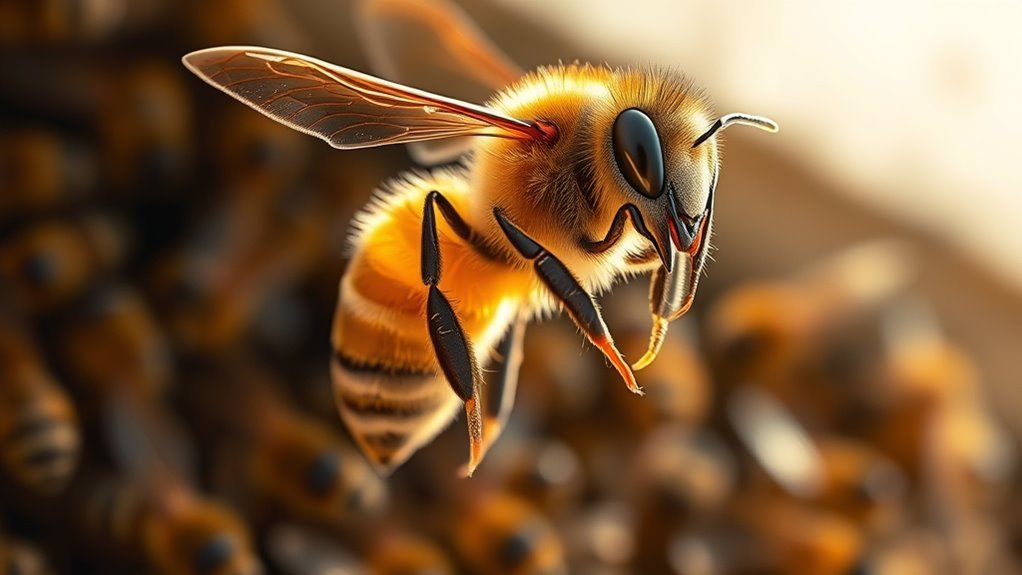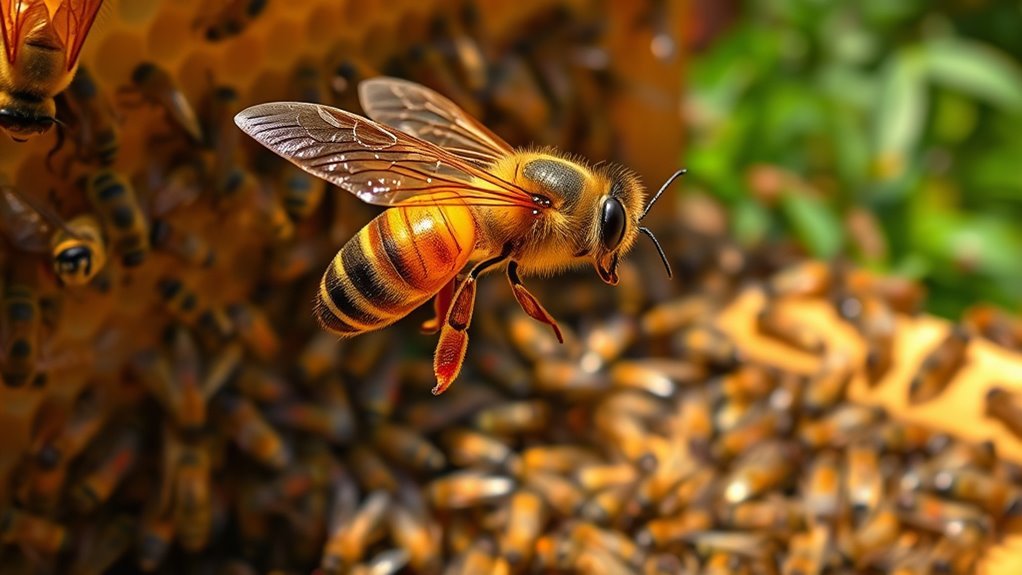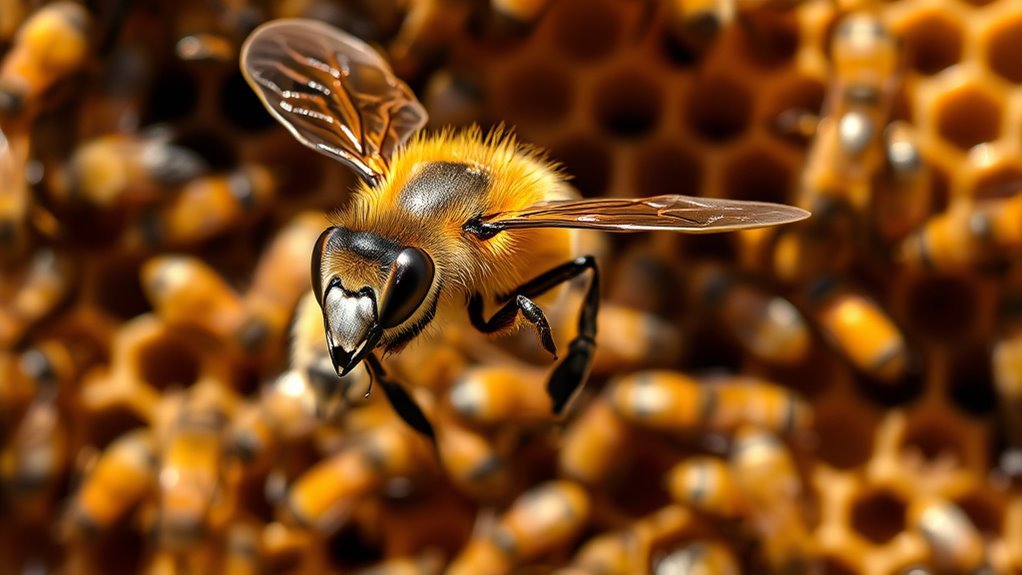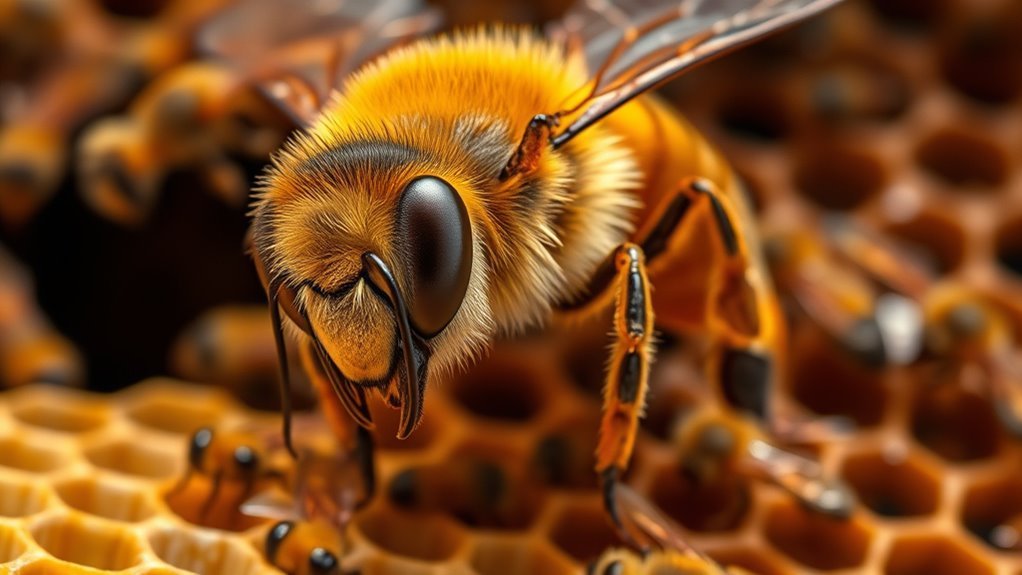You rely on drone bees primarily for reproduction—they’re the male bees whose sole function is to mate with a queen from another hive, ensuring genetic transfer and colony survival. Drones have distinct anatomy suited for mating and don’t engage in typical hive tasks like foraging. Their numbers are seasonally regulated by the colony to balance resources. If you want to understand how their behavior, lifecycle, and environmental challenges influence hive dynamics, there’s much more to explore.
Biology and Anatomy of Drone Bees

The biology and anatomy of drone bees reveal adaptations specialized for their reproductive role within the hive. When you examine drone anatomy, you’ll notice their larger, more robust bodies compared to worker bees, designed to support mating flights. They possess large compound eyes, which enhance visual acuity necessary for locating queen bees during flight. Unlike workers, drones lack stingers and pollen-collecting structures, reflecting their exclusive focus on reproduction. Drone biology also includes well-developed flight muscles that enable rapid, sustained flight critical for successful mating. Their reproductive organs, including large testes, are uniquely adapted to produce and deliver sperm efficiently. Understanding drone anatomy and drone biology highlights how these features support their singular function, granting them the freedom to fulfill their reproductive role without engaging in hive maintenance or foraging tasks.
Life Cycle and Development Stages

Although drone bees share many developmental stages with workers and queens, their life cycle exhibits distinct timing and biological features tailored to their reproductive purpose. You’ll find that a drone’s development stages—from egg to larva, pupa, and adult—span about 24 days, longer than worker bees but shorter than queens. During these stages, drones develop larger bodies and reproductive organs necessary for mating flights. The life cycle begins when the queen lays unfertilized eggs in drone cells, initiating haploid development. As you observe, drone larvae receive ample nutrition, supporting their growth to adulthood. Once mature, drones leave the hive to mate with queens, fulfilling their role before seasonal decline. Understanding these life cycle nuances helps you appreciate how drone development stages are optimized for successful reproduction within the colony.
Differences Between Drones and Worker Bees

Understanding the distinct roles within a bee colony requires comparing drones to worker bees, as their physical and behavioral differences reflect their specialized functions. You’ll notice drone characteristics include larger size, absence of stingers, and bigger eyes, all adapted for their reproductive role. Worker bees, meanwhile, carry a broad spectrum of responsibilities essential for colony survival.
Key distinctions include:
- Drones do not forage or tend to brood.
- Worker bees perform hive maintenance and defense.
- Drones have a single reproductive function.
- Workers regulate temperature and process food.
- Drone lifespan is shorter than workers’.
Mating Behavior and Reproductive Role
When you observe drone bees during the mating season, you’ll notice their primary purpose centers on reproduction, specifically mating with a queen from another hive. Drones engage in specific mating rituals that maximize their reproductive success, including congregating in designated drone congregation areas. These reproductive strategies increase the likelihood of successful mating by facilitating encounters with queens on mating flights. Unlike worker bees, drones do not partake in hive maintenance; their sole reproductive role is to pass on genetic material. After mating, drones typically die, highlighting the high stakes of their reproductive investment. Understanding these mating rituals and reproductive strategies reveals how drones contribute to genetic diversity and the overall health of bee populations, enabling you to appreciate their specialized function within the hive’s complex social structure.
Drone Flight Patterns and Mating Flights
Since drone bees rely exclusively on successful mating flights to fulfill their reproductive role, their flight patterns are highly specialized and consistent. Understanding drone navigation techniques and mating flight dynamics reveals how these bees enhance reproductive success. During mating flights, drones exhibit predictable behaviors:
- Depart hive during warm, sunny conditions for ideal navigation
- Use visual landmarks combined with solar cues for orientation
- Fly to specific drone congregation areas where queens are likely present
- Engage in rapid, aerial pursuit of queens during mating
- Return promptly to the hive post-flight, minimizing energy expenditure
These precise flight patterns enable drones to maximize encounters with virgin queens while conserving energy. By mastering these navigation techniques and adhering to specific mating flight dynamics, drones maintain their essential reproductive function within the hive.
How Drones Contribute to Genetic Diversity
The specialized flight patterns and mating behaviors of drone bees directly influence the genetic makeup of the hive’s offspring. Through selective drone selection, drones from multiple colonies congregate in drone congregation areas, facilitating mating with queens from different hives. This process promotes genetic variability by ensuring diverse genetic material is combined, enhancing colony resilience and adaptability. You’ll find that drones contribute uniquely by increasing allelic diversity, which supports disease resistance and environmental adaptability within the population. The freedom of drones to fly and mate beyond their natal hive is vital; it prevents inbreeding and strengthens the overall gene pool. Understanding how drones contribute to genetic diversity highlights their essential role in maintaining healthy, robust bee populations capable of thriving under various ecological pressures.
Seasonal Presence and Lifecycle Timing
You’ll notice that drone emergence aligns closely with specific seasonal cues, primarily in spring and early summer. Their population fluctuates considerably throughout the year, peaking when mating opportunities increase. Understanding these lifecycle duration patterns helps clarify their role within the hive’s reproductive cycle.
Drone Emergence Timing
Understanding when drone bees emerge within the hive is essential for grasping their role in colony dynamics and reproductive cycles. Drone emergence timing is closely linked to specific drone emergence triggers influenced by environmental cues. These cues signal the colony to initiate drone brood production, aligning with ideal mating conditions.
Key factors influencing drone emergence include:
- Increasing day length (photoperiod)
- Rising ambient temperatures
- Availability of sufficient food resources
- Queen’s reproductive status and pheromone levels
- Colony population density and health
Seasonal Population Fluctuations
Although drone populations vary throughout the year, their seasonal fluctuations are closely synchronized with environmental conditions and colony reproductive needs. You’ll observe that drone population dynamics respond directly to seasonal resource availability, which governs the colony’s decision to invest energy in producing males. During periods of abundant nectar and pollen, drones increase in number to maximize mating opportunities with queens from other colonies. Conversely, as resource scarcity approaches in late summer and fall, the hive reduces drone numbers to conserve energy. This cyclical pattern guarantees drones are present when mating flights are viable, yet limits their presence when survival conditions worsen. Understanding these seasonal trends helps you appreciate how the hive balances reproductive imperatives with environmental constraints, maintaining colony efficiency and genetic diversity.
Lifecycle Duration Patterns
When environmental conditions trigger the production of drones, their lifecycle duration aligns closely with seasonal cues to optimize reproductive success. You’ll notice that drone behavior and lifecycle stages are tightly regulated according to the hive’s reproductive calendar. This synchronization guarantees drones mature and participate in mating flights at the peak breeding period. Key lifecycle duration patterns include:
- Emergence in late spring or early summer
- Rapid development through pupal and adult stages
- Active mating flights during warm, calm afternoons
- Decline in drone numbers as the season ends
- Removal from the hive before winter to conserve resources
The Colony’s Management of Drone Population
You’ll notice that a colony regulates its drone population primarily through seasonal control, adjusting numbers to match environmental conditions. Resource allocation plays a critical role, ensuring drones don’t consume excessive nourishment needed for worker bees. Additionally, specific removal mechanisms are employed to eliminate surplus drones when their presence becomes detrimental to colony efficiency.
Seasonal Drone Population Control
Since drone bees serve primarily reproductive purposes, their population within a hive is tightly regulated throughout the year to maximize colony resources. You’ll notice that drone numbers increase in spring and early summer, aligning with peak mating opportunities. As the season changes, the colony employs specific drone survival strategies and queen selection criteria to control this population. Key factors include:
- Reducing drone brood production as resources dwindle
- Selective eviction of drones before winter
- Prioritizing drones with ideal genetic traits
- Monitoring environmental cues and resource availability
- Balancing energy investment between workers and drones
This seasonal control guarantees drones contribute effectively to reproduction without unduly taxing the hive. You’ll see that this dynamic regulation supports both the queen’s reproductive success and the colony’s long-term stability.
Resource Allocation Strategies
Managing the drone population involves strategic resource allocation to guarantee the colony’s overall efficiency and reproductive success. You’ll find that the hive dynamics dictate how much energy, food, and space are devoted to drones versus workers. Since drones do not contribute to foraging or hive maintenance, the colony carefully balances their numbers to avoid unnecessary consumption of resources. During periods of abundant nectar and favorable environmental conditions, the hive increases resource allocation to support drone rearing, maximizing mating opportunities. Conversely, when resources become scarce, the colony reduces drone production to conserve energy for essential tasks. This adaptive management reflects an evolved optimization within hive dynamics, ensuring that drones fulfill their reproductive role without compromising the colony’s stability or survival.
Drone Removal Mechanisms
Although drones play an essential reproductive role, the colony must actively regulate their numbers through specific removal mechanisms to maintain overall hive health. You should understand that uncontrolled drone populations can strain resources and compromise colony hygiene. The hive employs drone expulsion primarily during resource scarcity or seasonal shifts. Key drone removal mechanisms include:
- Selective eviction of surplus drones by worker bees
- Timing expulsions to coincide with reduced nectar flow
- Physical removal at hive entrance to prevent re-entry
- Limiting drone brood production through queen pheromone modulation
- Prioritizing colony hygiene by removing weak or diseased drones
Impact of Environmental Factors on Drones
When environmental conditions fluctuate, drone bees experience significant changes in behavior, physiology, and survival rates. You’ll find that pesticide exposure directly impairs drones’ neural functions, reducing their mating efficiency. Habitat loss and climate change further disrupt their natural foraging patterns by altering food availability and nesting sites. Temperature fluctuations and seasonal variations influence drones’ metabolic rates, affecting their activity levels and longevity. Pollution effects compound these stresses, weakening immune responses. As a result, drones may fail to fulfill their reproductive roles, jeopardizing colony sustainability. Understanding how these environmental factors intersect allows you to appreciate the delicate balance drones maintain within the hive ecosystem. By recognizing these influences, you can support practices that mitigate harm and promote conditions where drones thrive freely, ensuring the hive’s continued vitality.

